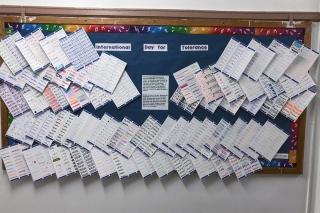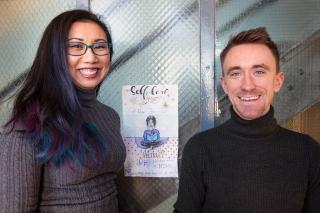What started two years ago as a club for LGBTQ students at IS 187 in Borough Park, Brooklyn, has quickly evolved into a group devoted to self-awareness and social advocacy that promotes tolerance and makes space for differences.
The student-run club, called SPECTRUM, has 65 members from the 6th, 7th and 8th grades. It includes students of various genders and sexualities, and many of the club’s members fall outside the LGBTQ community but consider themselves allies.
The students originally organized a Genders & Sexualities Alliance. “It was almost like a support group kind of thing when it first started,” said John Savarese, who teaches math at IS 187 and supervises SPECTRUM. He said the students at the time felt, “We’re gay, we’re 13, we want to talk about it.”
The club, which meets weekly on Thursday afternoons, still retains a core focus on LGBTQ issues, but now also addresses the overlap between these identities and other aspects of the children’s lives such as race, ethnicity and immigration status.
Many of the students’ families come from Asia and the Middle East, Savarese said, and discussions often turned to the relationship between those cultural identities and the students’ sexualities and genders.
The students began to ask questions about the intersection of ethnicity and gender such as, “What does it mean to be both? What does it mean to be just one?” according to Nicole Varugheese, a music teacher at the school and the club’s other supervisor.
Those questions gain added pertinence as some students’ families wouldn’t welcome their sexual orientation or gender if they knew about it. “They don’t know how to express it — how to be themselves — at home,” said Varugheese. “So it becomes a conversation here.”
For some students, the group provides a space to explore their evolving feelings about their identities. “They would identify differently at different points in the school year as they discover more about themselves,” said Savarese.
The teachers use educational resources from the LGBTQ student advocacy organization GLSEN to support the students’ discussions, and the club also works on projects for LGBTQ community needs. It raised $600 for the Trinity Place Shelter in 2017 and, at a meeting on Dec. 13, made posters for an upcoming fundraiser for the Ali Forney Center.
Both Trinity and Ali Forney serve LGBTQ homeless youth — who face double the risk for homelessness of non-LGBTQ youth, according to a 2018 report by Chapin Hall at the University of Chicago.
SPECTRUM also provides a safe space for kids to talk about the negative responses of some peers when they are open about their identities.
“Middle school is a time of trying new things and students pick up words they wouldn’t use before and they may not know it’s hurtful,” said Savarese. He says SPECTRUM members learn, “Don’t be confrontational, but don’t let it just happen. That’s really tricky for anyone — not just kids.”
Varugheese and Savarese said SPECTRUM’s social and emotional learning process empowers the students.
“Students take what they learned here and apply it in high school when they move on,” said Varugheese. “Some of these students have now become self-aware enough to talk to other teachers about it — and possibly teach them something as well.”

